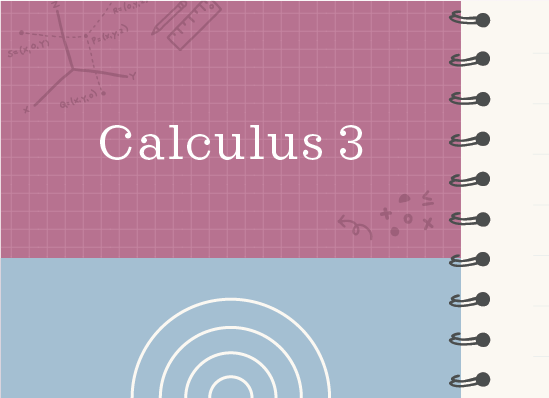Evaluating double integrals as iterated integrals
To evaluate a double integral, turn it into an iterated integral
A double integral has no explicitly defined limits of integration. Instead, the interval is some region ???R???, like
???\int\int_Rf(x,y)\ dA???
An iterated integral is one in which limits of integration have been clearly defined for each variable, like
???\int_0^4\int_0^2x+y^2+2\ dx\ dy???
Hi! I'm krista.
I create online courses to help you rock your math class. Read more.
Whenever we’re given a double integral, we want to turn it into an iterated integral, because with iterated integrals, we can easily evaluate one integral at a time, like we would in single variable calculus.
When we evaluate iterated integrals, we always work from the inside out. In the iterated integral above, because ???dx??? is on the inside and ???dy??? is on the outside, that means that the limits of integration ???[0,2]??? on the inside integral correspond to ???x??? and the limits of integration ???[0,4]??? on the outside integral correspond to ???y???.
Working from the inside out, we’ll integrate first with respect to ???x???, treating ???y??? as a constant, and we’ll evaluate over the ???x???-interval ???[0,2]???. Then we’ll integrate with respect to ???y??? and evaluate over the ???y???-interval ???[0,4]???.
How to solve a double integral by converting it into an iterated integral
Take the course
Want to learn more about Calculus 3? I have a step-by-step course for that. :)
Evaluating an iterated integral
Example
Evaluate the iterated integral.
???\int^2_0\int^3_1x^2y^3-xe^y\ dy\ dx???
Since ???dy??? is on the inside, we have to integrate with respect to ???y??? first. When we integrate with respect to ???y???, we treat ???x??? as a constant, similarly to the way we hold one variable constant when we take a partial derivative with respect to the other variable.
???\int^2_0\int^3_1x^2y^3-xe^y\ dy\ dx???
???\int_0^2x^2\left(\frac14 y^4\right)-x\left(e^y\right)\bigg|^{y=3}_{y=1}\ dx???
???\int^2_0\frac{x^2y^4}{4}-xe^y\bigg|^{y=3}_{y=1}\ dx???
Notice how we’ve indicated that we’re evaluating over the interval ???y=1??? to ???y=3???. It’s helpful to designate the variable that the interval applies to so that you remember to plug in for the right variable.
Now we can evaluate the interval. Since we took the integral with respect to ???y???, we’re evaluating the integral with respect to ???y???.
???\int^2_0\left[\frac{x^2(3)^4}{4}-xe^3\right]-\left[\frac{x^2(1)^4}{4}-xe^1\right]\ dx???
???\int^2_0\left(\frac{81x^2}{4}-xe^3\right)-\left(\frac{x^2}{4}-xe\right)\ dx???
???\int^2_0\frac{81x^2}{4}-xe^3-\frac{x^2}{4}+xe\ dx???
???\int^2_0\frac{80x^2}{4}-xe^3+xe\ dx???
???\int^2_020x^2-xe^3+xe\ dx???
Now we’ll take the integral with respect to ???x???.
???\frac{20x^3}{3}-\frac12 x^2e^3+\frac12 x^2e\bigg|^2_0???
Now, we can evaluate the interval. Remember we took the integral with respect to ???x??? so we are evaluating the the integral also with respect to ???x???.
???\frac{20(2)^3}{3}-\frac12 (2)^2e^3+\frac12 (2)^2e-\left[\frac{20(0)^3}{3}-\frac12 (0)^2e^3+\frac12 (0)^2e\right]???
???\frac{20(8)}{3}-\frac12 (4)e^3+\frac12 (4)e-\left(0-0+0\right)???
???\frac{160}{3}-2e^3+2e???
This is the value of the iterated integral, which means it’s the volume under the function ???f(x,y)=x^2y^3-xe^y??? over the region ???R=[0,2]\times[1,3]???.
Now let’s try an example with a double integral, where the intervals for ???x??? and ???y??? aren’t already incorporated into the integral.
When You’re given a double integral, You want to turn it into an iterated integral, because with iterated integrals, You can easily evaluate one integral at a time.
Example
Evaluate the double integral.
???\int\int_Ry\sin{(3x)}-y^3\cos{x}\ dA???
???R=\left\{(x,y)\big|0\le{x}\le\frac{\pi}{2},-1\le{y}\le2\right\}???
The question is asking us to evaluate a double integral, and they’re giving us ???R???. The values in ???R??? correspond to the ???x??? and ???y??? intervals for our double integral, so we can go ahead and insert this information into the double integral to turn it into an iterated integral.
???\int\int_Ry\sin{(3x)}-y^3\cos{x}\ dA???
???\int_0^\frac{\pi}{2}\int_{-1}^2y\sin{(3x)}-y^3\cos{x}\ dy \ dx???
It doesn’t matter if we put ???dx??? on the inside and ???dy??? on the outside, or vice versa. But we need to make sure that the limits of integration on each integral match the order of ???dx??? and ???dy???. Since we put ???dy??? on the inside, the limits of integration for ???y??? have to get attached to the inside integral. And since ???dx??? is on the outside, we put the limits of integration for ???x??? on the outside integral.
Since ???dy??? is on the inside, and we always work our way inside out, we’ll integrate first with respect to ???y???, treating ???x??? as a constant.
???\int_0^\frac{\pi}{2}\frac12 y^2\sin{(3x)}-\frac14 y^4\cos{x}\bigg|_{y=-1}^{y=2}\ dx???
Now we’ll evaluate over the interval for ???y???.
???\int_0^\frac{\pi}{2}\frac12 (2)^2\sin{(3x)}-\frac14 (2)^4\cos{x}-\left[\frac12 (-1)^2\sin{(3x)}-\frac14 (-1)^4\cos{x}\right]\ dx???
???\int_0^\frac{\pi}{2}\frac12 (4)\sin{(3x)}-\frac14 (16)\cos{x}-\left[\frac12 (1)\sin{(3x)}-\frac14 (1)\cos{x}\right]\ dx???
???\int_0^\frac{\pi}{2}2\sin{(3x)}-4\cos{x}-\frac12 \sin{(3x)}+\frac14 \cos{x}\ dx???
???\int_0^\frac{\pi}{2}\frac32\sin{(3x)}-\frac{15}{4}\cos{x}\ dx???
Next we’ll integrate with respect to ???x???, then evaluate over the ???x???-interval.
???-\frac32\left(\frac13\right)\cos{(3x)}-\frac{15}{4}\sin{x}\bigg|_0^\frac{\pi}{2}???
???-\frac12\cos{(3x)}-\frac{15}{4}\sin{x}\bigg|_0^\frac{\pi}{2}???
???-\frac12\cos{\left(3\cdot\frac{\pi}{2}\right)}-\frac{15}{4}\sin{\frac{\pi}{2}}-\left[-\frac12\cos{(3\cdot0)}-\frac{15}{4}\sin{0}\right]???
???-\frac12\cos{\frac{3\pi}{2}}-\frac{15}{4}\sin{\frac{\pi}{2}}+\frac12\cos{0}+\frac{15}{4}\sin{0}???
???-\frac12(0)-\frac{15}{4}(1)+\frac12\cos{0}+\frac{15}{4}\sin{0}???
???-0-\frac{15}{4}+\frac12(1)+\frac{15}{4}(0)???
???0-\frac{15}{4}+\frac12+0???
???-\frac{15}{4}+\frac24???
???-\frac{13}{4}???
The value of the double integral is ???-13/4???, which means the volume under the function ???f(x,y)=y\sin{(3x)}-y^3\cos{x}??? over the region ???R=\left[0,\frac{\pi}{2}\right]\times\left[-1,2\right]??? is ???-13/4???.






